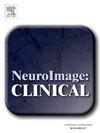Large-scale functional network connectivity mediate the associations of white matter lesions with executive functions and information processing speed in asymptomatic cerebral small vessels diseases
IF 3.4
2区 医学
Q2 NEUROIMAGING
引用次数: 0
Abstract
Objective
To examine the role of the large-scale functional network connectivity between white matter lesions (WMLs) and cognitive behaviors in patients of asymptomatic cerebral small vascular diseases (CSVD).
Methods
The study sample consisted of 211 asymptomatic CSVD patients with WMLs. Large-scale internetwork and intranetwork functional connectivity (FC) were calculated using a combination of resting-state functional MRI data and independent component analysis. Neuropsychological tests involve cognitive functions were also measured. Then, potential correlations between WMLs, functional network connectivity and cognitive behaviors were tested. Mediation analysis was used to explore the role of functional network connectivity between WMLs and cognitive behaviors.
Results
We successfully identified fourteen meaningful resting-state functional networks. Internetwork FC between dorsal sensorimotor network (dSMN) and right frontoparietal network (rFPN), dSMN and left frontoparietal network (lFPN), auditory network (AN) and posterior default network (pDMN), AN and executive control network (ECN), ECN and salience network (SN), dorsal attention network (DAN) and ECN were significant correlated with volumes of WMLs. Executive function were associated with internetwork FC between AN and pDMN, ECN and SN. Moreover, internetwork FC between AN and pDMN, ECN and SN mediated the relations of WMLs with executive function (for AN and pDMN, indirect effect: −0.0371, 95% CI: −0.0829 to −0.0073; for ECN and SN, indirect effect: −0.03191, 95% CI: −0.0807 to −0.0047). Moreover, left inferior parietal lobule in rFPN, right precentral gyrus in anterior default network (aDMN), right paracentral lobue in pDMN and left precunues in ECN were related to volumes of WMLs. There is a significant association of WMLs with intranetwork FC in left precunues, which could mediate the link between WMLs and information processing speed (indirect effect: −0.0437, 95% CI: −0.1055 to −0.0081).
Conclusion
WMLs in asymptomatic CSVD patients may induce large-scale connectivity changes including the internetwork FC and intranetwork FC, which might further influence executive function and information processing speed.
无症状小血管疾病脑白质病变与执行功能和信息处理速度的关系
目的探讨无症状脑小血管疾病(CSVD)患者脑白质病变(WMLs)与认知行为之间的大规模功能网络连接的作用。方法211例无症状CSVD合并脑白质损伤患者为研究对象。使用静息状态功能MRI数据和独立成分分析相结合的方法计算大规模网络间和网络内功能连通性(FC)。包括认知功能在内的神经心理学测试也被测量。在此基础上,对脑残学习、功能网络连接和认知行为之间的潜在相关性进行了测试。采用中介分析的方法探讨功能网络连通性对认知行为的影响。结果成功识别出14个有意义的静息状态功能网络。背侧感觉运动网络(dSMN)与右侧额顶叶网络(rFPN)、dSMN与左侧额顶叶网络(lFPN)、听觉网络(AN)与后端默认网络(pDMN)、AN与执行控制网络(ECN)、ECN与显著性网络(SN)、背侧注意网络(DAN)与ECN之间的互联网络FC与脑损伤体积呈显著相关。执行功能与AN与pDMN、ECN与SN之间的互联FC有关。此外,AN和pDMN、ECN和SN之间的网络FC介导了脑损伤与执行功能的关系(AN和pDMN的间接效应:−0.0371,95% CI:−0.0829 ~−0.0073;对于ECN和SN,间接效应:−0.03191,95% CI:−0.0807至−0.0047)。rFPN左侧顶叶下小叶、aDMN右侧中央前回、pDMN右侧中央旁小叶和ECN左侧前叶与脑白质损伤的体积有关。脑损伤与左前叶内网络FC显著相关,这可能介导脑损伤与信息处理速度之间的联系(间接效应:−0.0437,95% CI:−0.1055 ~−0.0081)。结论无症状CSVD患者脑白质损伤可引起包括网络间FC和网络内FC在内的大规模连通性改变,进而影响执行功能和信息处理速度。
本文章由计算机程序翻译,如有差异,请以英文原文为准。
求助全文
约1分钟内获得全文
求助全文
来源期刊

Neuroimage-Clinical
NEUROIMAGING-
CiteScore
7.50
自引率
4.80%
发文量
368
审稿时长
52 days
期刊介绍:
NeuroImage: Clinical, a journal of diseases, disorders and syndromes involving the Nervous System, provides a vehicle for communicating important advances in the study of abnormal structure-function relationships of the human nervous system based on imaging.
The focus of NeuroImage: Clinical is on defining changes to the brain associated with primary neurologic and psychiatric diseases and disorders of the nervous system as well as behavioral syndromes and developmental conditions. The main criterion for judging papers is the extent of scientific advancement in the understanding of the pathophysiologic mechanisms of diseases and disorders, in identification of functional models that link clinical signs and symptoms with brain function and in the creation of image based tools applicable to a broad range of clinical needs including diagnosis, monitoring and tracking of illness, predicting therapeutic response and development of new treatments. Papers dealing with structure and function in animal models will also be considered if they reveal mechanisms that can be readily translated to human conditions.
 求助内容:
求助内容: 应助结果提醒方式:
应助结果提醒方式:


